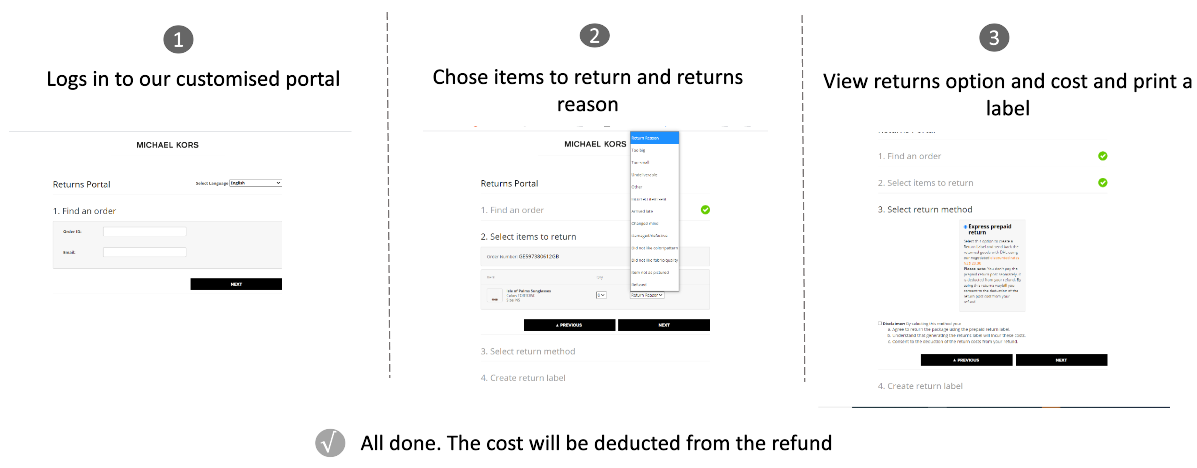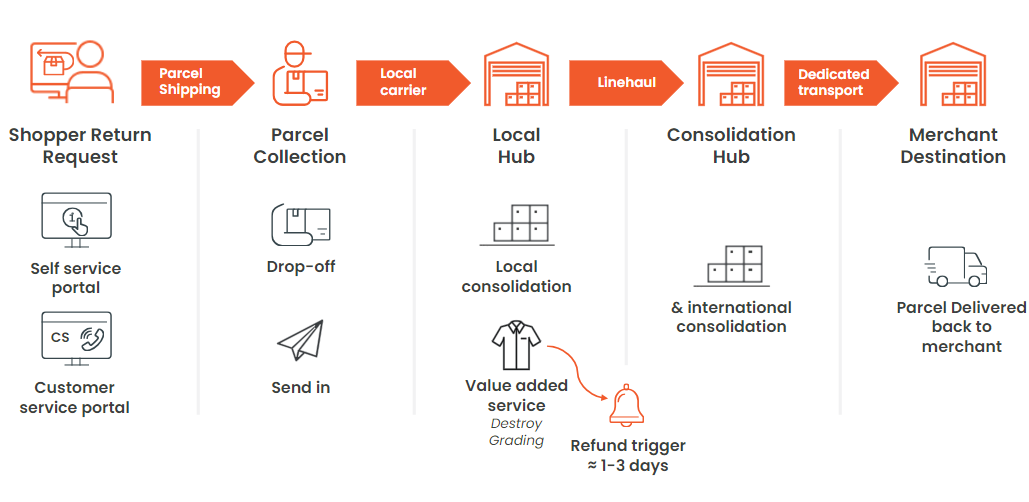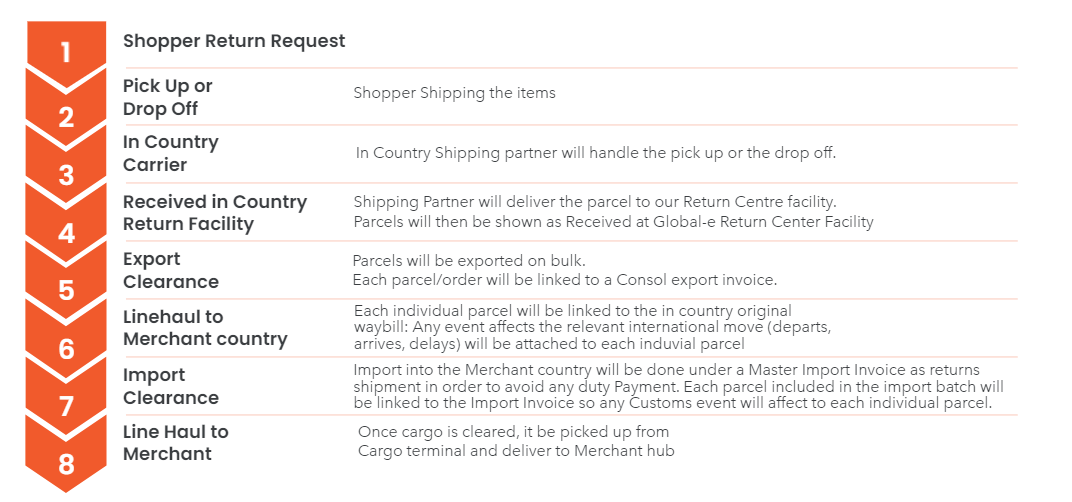Returns and Replacements
This section provides guidelines and processes for handling customer returns and replacements.
Merchants can facilitate returns with one of the following methods:
Prepaid Courier: Customers use a prepaid shipping label to return products via a courier.
Consolidated Returns: Multiple returns are grouped and shipped together to reduce costs.
Return to Shop: Customers return items directly to a store location for processing.
Self-postage: Customers can send back the items themselves.
Returns in the US
Service Level | Pros | Cons | Comments |
|---|---|---|---|
Door-to-door |
| Expensive |
|
Consolidated |
|
|
Prepaid Courier Returns
Global-e offers an international prepaid solution via the Return Portal.
This option allows merchants to set a fixed returns fee (similar to the outbound flat rate), which will be deducted from the customer refund.
Returned parcels can be collected from the customer by a courier or dropped off at a local service point/PUDO. The parcel is then shipped directly back to the merchant's returns facility.
Service Levels
Global-e can support two service levels, based on the origin and destination of the shipment.
DHL Express - can be offered worldwide
DHL Economy Road - can be offered all across Europe
The Customer Journey

Consolidated Returns
Consolidated returns optimize the process of managing international returns, making it more efficient and cost-effective for merchants.
Overview of the consolidated returns process:
The customer sends the returned product to a nearby Global-e hub or consolidation center.
All individual returns are batched together into a single shipment and sent back to the relevant destination—be it in the UK, US, or EU.
For merchants with high return volumes, these consolidated returns can be shipped directly back to the merchant’s hub, bypassing additional handling steps.
For merchants with lower volume, the consolidated pallets are sent from the local Global-e hub in the UK, US, or EU back to the merchant’s hub. This ensures that returns are managed effectively regardless of volume.
Global-e offers consolidated returns solutions across several markets including the UK, US, and the Netherlands/EU. This service is designed for eligible merchants seeking efficient reverse logistics solutions.
Consolidated Returns Services and Flows
The step-by-step process of consolidated returns.
This streamlined process helps reduce costs and improve efficiency for merchants handling returns from various regions.

Shopper Return Request The customer initiates a return through either a self-service or customer service portal.
Parcel Collection: The customer drops off or sends the parcel to a designated collection point.
Local Hub: The parcel is then picked up by a local carrier and sent to a local consolidation hub, where value-added services like item grading or destruction can occur. The refund is triggered within 1-3 days at this stage.
Consolidation Hub: Parcels are consolidated locally and internationally for efficiency, then prepared for shipping back to the merchant.
Merchant Destination: Using dedicated transport, the consolidated shipment is delivered to the merchant's destination or return facility.
Detailed Operational Flow
This process ensures smooth international returns with full tracking and documentation at each stage.

Shopper Return Request: The customer initiates a return by shipping the items.
Pick Up or Drop Off: The return is either dropped off by the shopper or picked up by the shipping service.
In Country Carrier: A local shipping partner collects or receives the return package.
Received in Country Return Facility: The shipping partner delivers the package to Global-e’s return center, where it is logged as received.
Export Clearance: All parcels are bulk exported, each linked to a consolidated export invoice.
Linehaul to Merchant Country: Each parcel is tracked during its international journey, with details of any transit delays or events attached to the individual waybill.
Import Clearance: Importation into the merchant's country is managed under a Master Import Invoice to avoid duties. Each parcel’s details are linked to this invoice for customs
Line Haul to Merchant: Once cleared, the cargo is picked up and delivered to the merchant's hub or return facility.
Return to Shop
Global-e supports a Return-to-Shop option for customers wishing to return their orders to an international store, either owned or franchised.
Below is the process for the return handling and setup of this service:
Customer Initiates Return: The customer returns the items to the store with the invoice, either with or without printed return documents.
Store Staff Actions:
Store staff logs into the Global-e portal and locates the order associated with the returned items.
They process the Return Merchandise Authorization (RMA) or non-RMA as required.
The store staff prepares the parcel for return shipment to the merchant.
Parcel Preparation:
All RMAs are consolidated as consignments.
The End-of-Day (EOD) procedure is performed.
Required documents are printed and affixed to the parcel:
Return Proforma Invoice: Consolidated return invoice for all consignments.
Return Shipping Label: One label for each consignment.
Ship-to-shop Configuration
The following process applies to the initial setup and to updating an existing configuration.
Follow the process outlined on the Confluence page: [COOR board task mapping >store Collection].
The Customer Success Manager (CSM) will request the merchant to complete the required information template provided in the Confluence link.
The CSM will open a ticket for the COOR team with the completed template attached. Example tickets are available on the Confluence page.
The CSM will arrange training with the merchant and the Technical Operations team.
Note
The estimated time for this process is about 1.5 weeks.
Additional Information
Checkout Locations: It is possible to configure stores as delivery locations in addition to enabling returns.
Product Return Flexibility: Customers can return products to any store within the country where the original order was shipped.
Return-to-Shop Independence: The Return-to-Shop service can operate independently of the Ship-to-Shop service.
Refund Process Duration: The return shipping to the hub may take time, depending on shipping settings and merchant decisions. This can result in a longer time for the customer to receive their refund, which is processed once the goods arrive at the hub and are inspected.
Support Contacts:
For assistance, store staff should first contact their regional manager.
If issues persist, escalate to the business lead.
If additional support is needed, contact GE Technical Support.
Merchant Responsibility: It is the merchant’s duty to inform customers about the available store locations for returns.
Self-Postage
The self-postage option allows customers to create a return label and send back the returned goods with the shipper of their choice.
Note
If the customer opts to return the goods with the merchant's shipper, Global-e is unable to offer tracking services or fixed return priceing. As a result, this return option is not recommended.
FAQ - Returns & Replacements
Can Dangerous Goods be returned?
No, dangerous goods cannot be returned. This is because shipping dangerous goods requires special handling which cannot be supported on customer returns.
Can refunds be automated based on carrier return tracking status
Yes, but only for DHL Express returns.
The DHL Express status is “delivered” which means it is delivered to the brand's warehouse.
The following rules apply for the automated refund amount:
Product price and any D&T built into product price is auto-refunded.
D&T as a separate line item is not auto-refunded.
Original shipping is not auto-refunded.
Cost of return shipping label, if configured, is automatically deducted from the auto-refund amount.
Can WYOL shipments be returned using Global-e carriers?
Global-e cannot support a setup of WYOL outbound and Global-e returns. This type of setup creates complexity and exposure on our side.
The main reason is that in the case of outbound WYOL we don’t have the paper trail (Export docs, D&T paid). So, if the goods are being returned under our shipping account we are exposed to D&T when entering the country.
How are replacement shipping and D&T handled in the reconciliation process?
In most cases, the merchant covers the shipping and D&T for the replacement order (this is the default settings, however merchants can choose to untick this box) .
In such cases, the merchant is charged for the D&Ts.
In order to reflect the charges for shipping and D&Ts, a line is added to the shipping per parcel tab once that order reaches the ‘Received in hub’ status. In this tab, there is column to flag replacement orders. 0 represents a standard order and 1 a replacement. Otherwise, the shipping and D&Ts are recorded as any other order in the ShippingPerParcel tab.
For those orders which are replacements, it is important to note that the shipping tab is the only place this order will appear. It will not appear in the Orders or Products tabs (and whilst unlikely, this also extends to Refunds, RefundComponents and Returns).
How do replacement orders appear in the reconciliation report?
Replacement orders will appear in the ‘shipping per parcel ‘ tab, in the column where replacement orders are flagged - '0' represents a standard order and '1' a replacement. For orders which are replacements, it is important to note that the shipping tab is the only place this order will appear. It will not appear in the Orders or Products tabs.
Is D&T applicable on a replacement if the value is zero?
Replacement orders are liable for full D&T even if the customer is not charged again. Customs does not accept a replacement value (‘zero value’) because from customs point of view, the product has a retail value, which can be checked online.
If the value declared is lower than the value online, the shipment can be stopped and a fine can be assessed. This is correct for product replacements, exchanges, or repaired items.